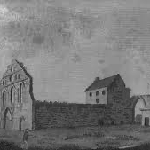Annotation:Kilwinning's Steeple
X:1 T:Kilwinning Steeple M:C L:1/8 R:Reel C:"By the late Hugh Gilmour" N:"Printed for the first time." B:Manson - Hamilton's Universal Tune Book (18, p. 168) Z:AK/Fiddler's Companion K:A g|a2 (ec) defg|afec dBBg|a2 (ec) defg|afec A2A:| B|{d}c2 (cA) d2 (dB)|efec dBBd|{d}c2 (cA) defg|afec A2 (AB)| c2 (cA) d2 (dB)|efec dBBd|ceae defg|afec A2A||
KILWINNING('S) STEEPLE. AKA and see "Clock in the Steeple (The)," "Prince of Wales' Fancy (The)," "Templeglantine (1)." Scottish, Reel. A Major. Standard tuning (fiddle). AB. The reel "Kilwinning Steeple" is credited (in Manson's Hamilton's Universal Tune Book, 1853, p. 168) to Hugh Gilmour, a blind fiddler from Stevenston, Ayrshire, who died in 1822. Manson indicates the tune was published by him for the first time. The melody is similar to the Scottish song "There's nae luck aboot the hoose (there's nae luck ava)."

The curious word Popingoe is explained by Robert Forsyth, in his The Beauties of Scotland (1805).
In some measure connected with this abbey is a company or society of archers, which is said to have existed here as far back as 1488; at least this date is asserted in a minute in their records dated September 1688, which is signed by a number of gentlemen. Archery is practiced here annually, usually in the month of June. We have said that the institution is connected with the monastery. This is rendered probable from the sorts of archery which have been used from time immemorial. It is of two species. The one is an elevated mark, called a popingoe. The popingoe is a bird known in heraldry. It is on this occasion cut out in wood, fixed on the end of a pole, and placed 120 feet high on the steeple of the monastery. The archer who shoots down this mark is honored with the title of 'Captain of the Popingoe'. He is master of the ceremonies of the succeeding year, sends cards of invitation to the ladies, gives them a ball and supper, and transmits his honours to posterity by a medal, with suitable devices, appended to a silver arrow. [p. 405]
See also "Kilwinning Archers' Strathspey" which title also honors the event. The alternate title "Pope's Toe (The)" is a corruption of Popingoe.
"Kilwinning Steeple" was entered into the large 19th century music manuscript collection[2](No. 221, p. 61) of prosperous dairy farmer, miller, sometime printer and bookbinder, and fiddler James Barry (1819-1906) of Six Mile Brook, Pictou County, northern Nova Scotia. Barry added a note that the reel was to follow "Mrs. Parker's Strathspey," the tune he paired it with in playing.

